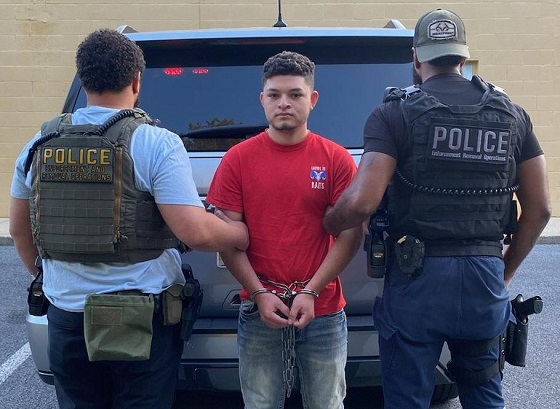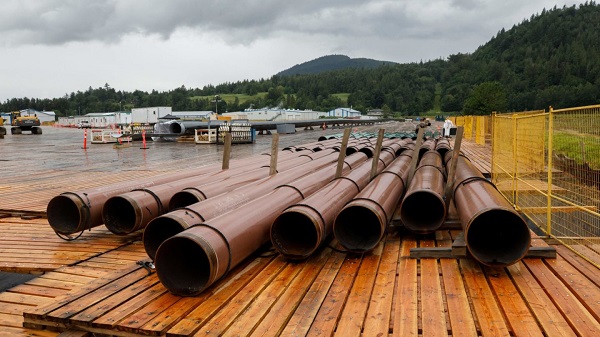ICE-ERO Baltimore Fugitive Operations agents arrested and removed 19-year-old Guatemalan national Henry Argueta-Tobar, who was illegally in the country and convicted of raping a Maryland resident.
U.S. Immigration and Customs Enforcement
By Bethany Blankley
387,000 criminal noncitizens arrested by ICE between fiscal 2021 and 2023
More than 660,000 criminal foreign nationals identified to be deported by U.S. Customs and Immigration Enforcement are freely living in communities nationwide.
Among them are those convicted or charged with violent crimes, including homicide, sexual assault and kidnapping, according to information released in response to a congressional request.
ICE was requested to provide information about the number of noncitizens on its docket for removal who are convicted or charged with a crime. As of July 21, 2024, “there were 662,566 noncitizens with criminal histories on ICE’s national docket, which includes those detained by ICE, and on the agency’s non-detained docket. Of those, 435,719 are convicted criminals, and 226,847 have pending criminal charges,” ICE Deputy Director Patrick Lechleitner said.
This includes criminal foreign nationals convicted of, or charged with, homicide (14,914), sexual assault (20,061), assault (105,146), kidnapping (3,372), and commercialized sexual offenses, including sex trafficking (3,971).
An additional 60,268 are on the list for burglary/larceny/robbery; 126,343 for traffic offenses including driving under the influence (DUIs) and 16,820 for weapons offenses.
ICE’s national docket refers to illegal foreign nationals who were apprehended by Border Patrol agents who then turn them over to ICE. Despite having a confirmed documented criminal history, ICE released them into the United States.
Lechleitner notes that some local jurisdictions “have reduced their cooperation with ICE, to include refusal to honor ICE detainer requests, even for noncitizens who have been convicted of serious felonies and pose an ongoing threat to public safety” due to their so-called “sanctuary city” policies. “However, ‘sanctuary’ policies can end up shielding dangerous criminals, who often victimize those same communities,” he said.
Because of local jurisdictions refusing to cooperate with ICE, the agency lifted detainers for 24,796 known criminals and released them into the U.S., he said. The data is from Oct. 1, 2020, through July 22, 2024.
Among them, state and local law enforcement agencies refused to comply with 23,591 detainer requests; 1,205 detainer requests were lifted “due to insufficient notice to ICE.”
Also during this period, ICE Enforcement and Removal Operations issued 2,897 detainers that were declined by state or local law enforcement agencies even after the subject of the detainer request had a subsequent apprehension by ICE ERO, according to the report.
Lechleitner also notes that “most noncitizens who are convicted of homicide are typically not eligible for release from ICE custody under §236(c) of the Immigration and Nationality Act” but “ICE officers may use their discretion in making custody determinations and release noncitizens with conditions.” He says these determinations are made on a “case-by-case basis.”
In response, U.S. House Committee on Homeland Security Chairman Mark Green, R-TN, said, “It may be shocking to hear that the Biden-Harris administration is actively releasing tens of thousands of criminal illegal aliens into our communities, but their own numbers conclusively prove this to be the case.
“This defies all common sense. Under President Biden and his ‘border czar,’ Vice President Harris, DHS law enforcement has been directed to mass-release illegal aliens whom they know have criminal convictions or are facing charges for serious crimes – and these dangerous, destructive individuals are making their way into every city and state in this country. How many more Americans need to die or be victimized before this administration is forced to abide by the laws they swore to uphold?
“This is madness. It is something no civilized, well-functioning society should tolerate.”
Texas Gov. Greg Abbott said the number was “shocking.”
“If accurate, it means that almost 10%” of the criminal illegal foreign nationals released into the country by the Biden-Harris administration “are criminals. It also debunks the narrative that illegal immigrants are less likely to commit crime. We can’t survive four more years of this.”
More than 387,000 criminal noncitizens were arrested by ICE ERO agents in fiscal years 2021 through 2023, The Center Square first reported.
The majority arrested were citizens of Mexico, Nicaragua, Columbia and Venezuela.
The majority of arrests occurred in Dallas and Houston, Texas, according to an ICE online statistical dashboard. The most common arrests are of those convicted of DUIs, drug possession, and assault and criminal (non-civil) traffic offenses like hit-and-run or leaving the scene of an accident, ICE says.
Additionally, a separate data point shows that U.S. Customs and Border Protection and Border Patrol apprehensions of criminal noncitizens totaled nearly 54,000 since fiscal 2021, according to CBP data as of Sept. 16. The majority were for illegal entry and reentry and DUIs.
Related
















